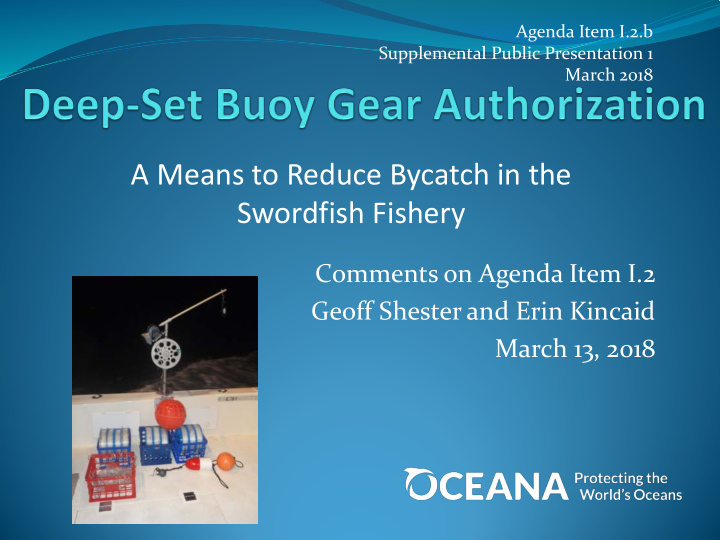



Agenda Item I.2.b Supplemental Public Presentation 1 March 2018 A Means to Reduce Bycatch in the Swordfish Fishery Comments on Agenda Item I.2 Geoff Shester and Erin Kincaid March 13, 2018
Outline Timeline DSBG versus DGN Preferred Alternative Limited Entry Permit Issuance Trade-in Option Summary
Timeline DSBG experiments 2011-2015 DSBG introduced to Council in 2012 PFMC recommends DGN hard caps & 100% monitoring Sept. 2015 DSBG EFPs 2016-Present PFMC DSBG Scoping March 2016 PFMC DSBG Initial ROA June 2017
Night Drift gillnets Surface fishing at night • Deep-set buoy gear Among highest discard rates in US (>60%) • Deep fishing in day • Over 70 species discarded as bycatch • 98% marketable species • No hard cap rule; no monitoring rule Active tending Minimal bycatch • • Kills or injures multiple ESA-listed species • mortality and dozens of marine mammal species Profitable, higher value catch •
Marine Mammal Takes per 1000 Swordfish 40 30 20 30.3 10 2.8 0 DGN (2004-2014) DSBG (2011-2017)
Management tools to minimize DGN bycatch 100% monitoring Hard caps on bycatch Phase-out DGN gear Reduce # of DGN permits and/or effort Time/area closures
Management tools to minimize DGN bycatch 100% monitoring Hard caps on bycatch Phase-out DGN gear Reduce # of DGN permits and/or effort Time/area closures
Management tools to minimize DGN bycatch 100% monitoring Hard caps on bycatch Phase-out DGN gear Reduce # of DGN permits and/or effort Time/area closures
DSBG Authorization –Top Priority Achieve DGN bycatch reduction in light of NMFS’ withdrawal of DGN hard caps Significant interest in the fishery Reduced observer costs to DSBG fishermen Increase U.S. West Coast swordfish production, support development of new markets
Recommendations Authorize DSBG with ability to phase-in LBG Establish Limited Entry Program Purpose: reduce bycatch Initial allocation based on EFP pioneers and active DGN swordfish fishermen Trade-in option
Limited Entry Question 1: Can the PFMC establish a limited entry program for DSBG? YES! Broad authority to establish limited entry under MSA to achieve Optimum Yield 16 U.S.C. § 1853(b)(6) 50 CFR 600.330(c): Limited entry may be used to “contribute to economic efficiency or conservation.” “combat overfishing, overcrowding, or overcapitalization” or in an “unutilized or underutilized fishery,” to “reduce the chance that these conditions will adversely affect the fishery in the future.” “to provide adequate economic return to pioneers in a new fishery.”
Limited Entry Question 2: Should the Council authorize a limited entry fishery? Reward DSBG fishery pioneers Address DGN conservation concerns- incentive to reduce bycatch Prevent overcrowding Controlled growth of new fishery
Trade-in option Active DGN permit holders may trade-in DGN permit and gear in exchange for a transferable DSBG permit Strictly voluntary Transforms existing LE DGN permits without creating new LE permits with market value A DSBG permit could become more valuable than a DGN permit Helps compensate fishermen who voluntarily surrender DGN permit/gear Links DSBG authorization to DGN bycatch minimization goals
Proposed Initial Permit Issuance DSBG Eligibility Rationale Transferable? Max potential # Original EFP Reward fishery No 6 participants pioneers Active* DGN permit Reduce DGN No 25 holders effort/bycatch Active* DGN permit Reduce DGN Yes 25 trade-in permits/bycatch Total 56 *Active defined by landings since 2012 PFMC would evaluate additional permit issuance during biennial specifications
Summary DSBG is the best available path to a sustainable West Coast swordfish fishery Do not delay: Authorize and establish a limited entry DSBG permit program with a DGN trade-in component in June 2018 New opportunity to fish with clean gear and reduce bycatch
Recommend
More recommend